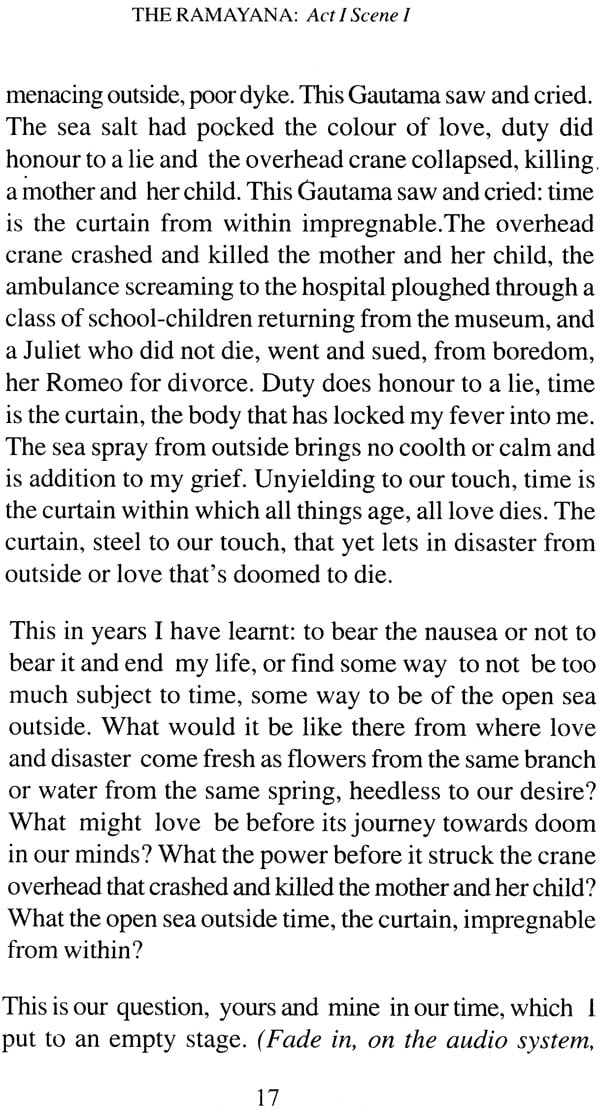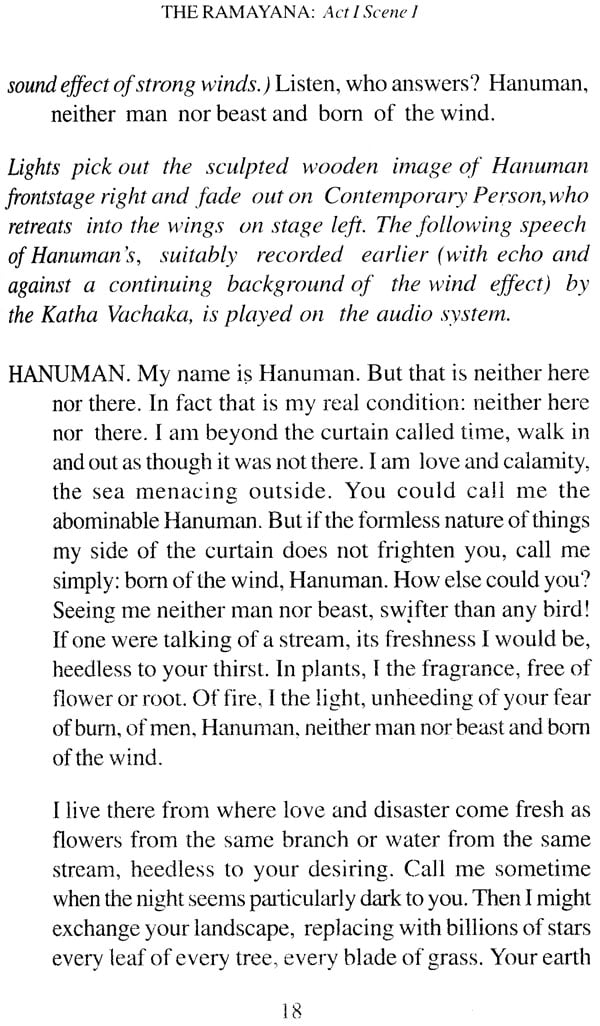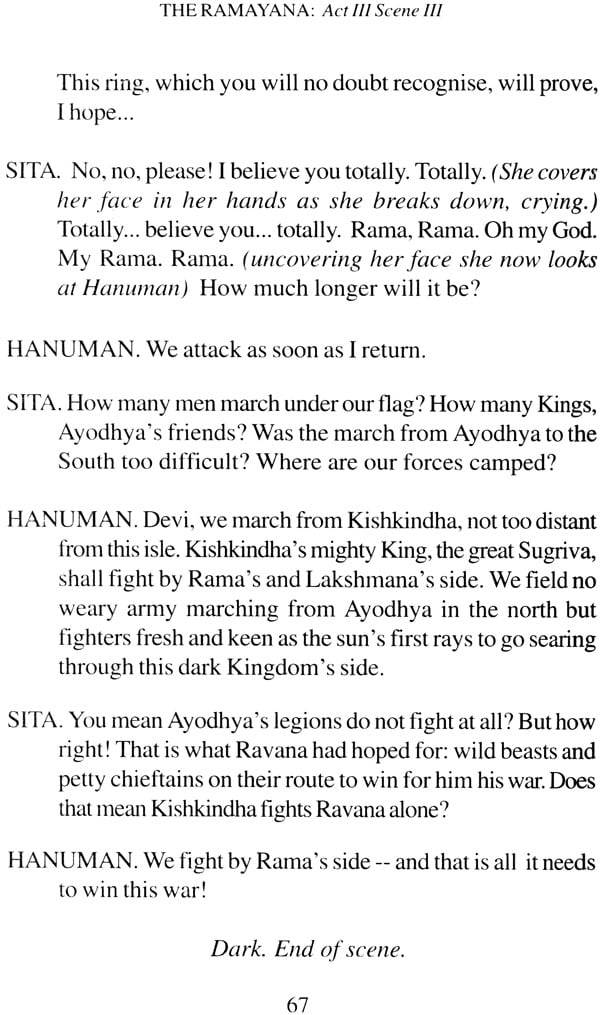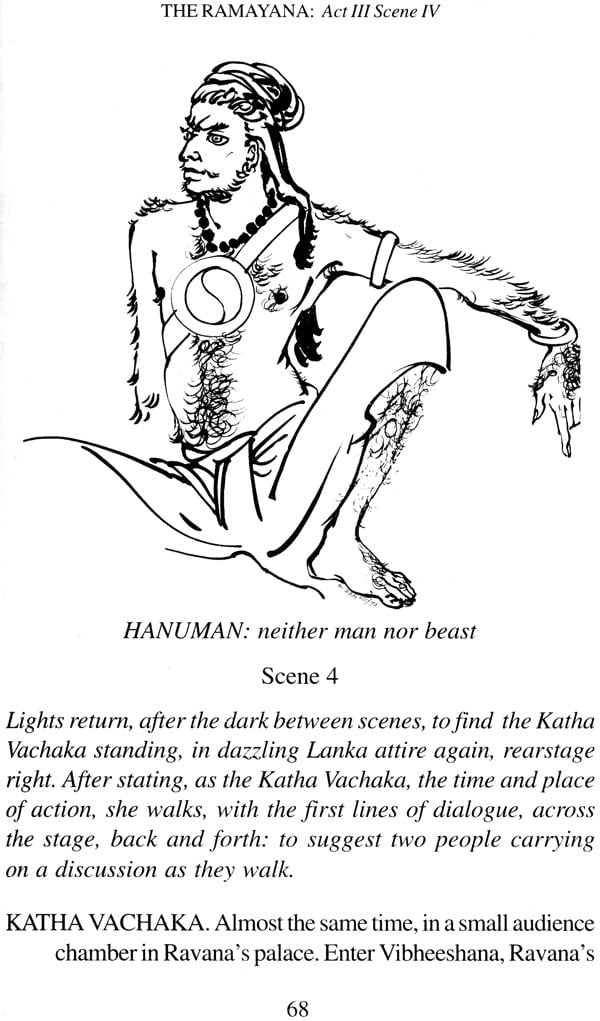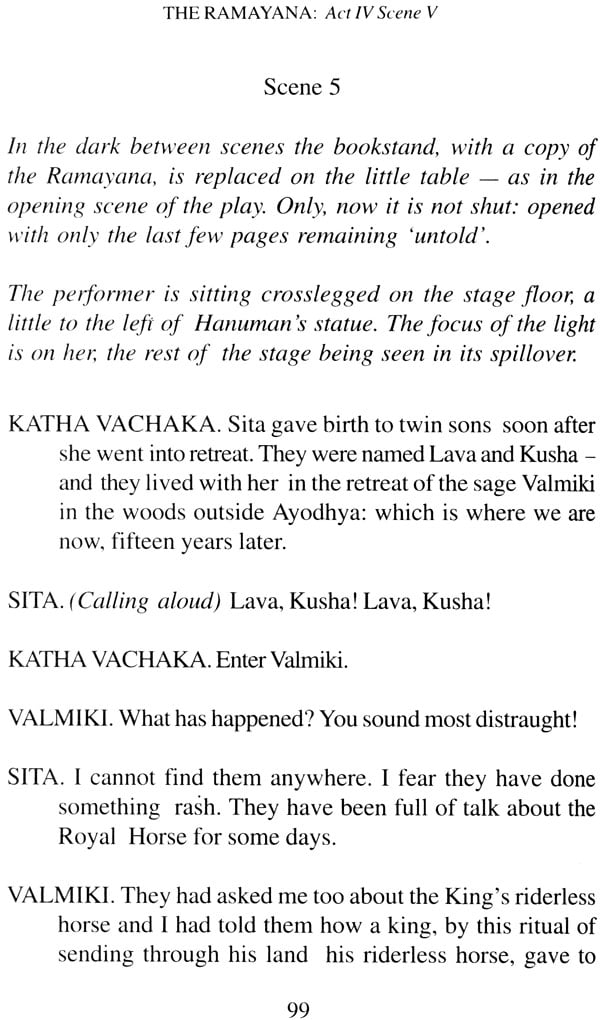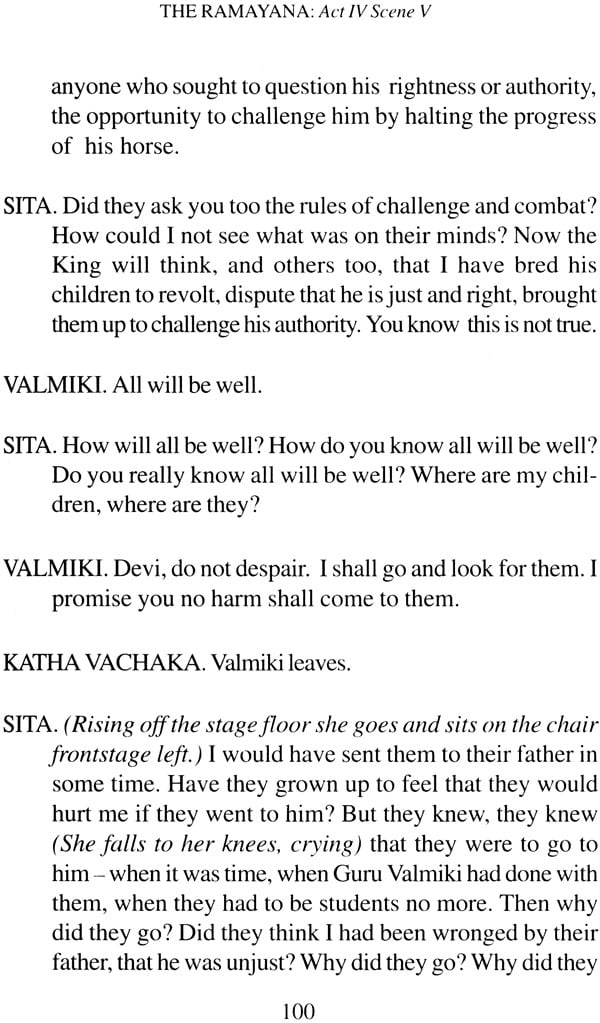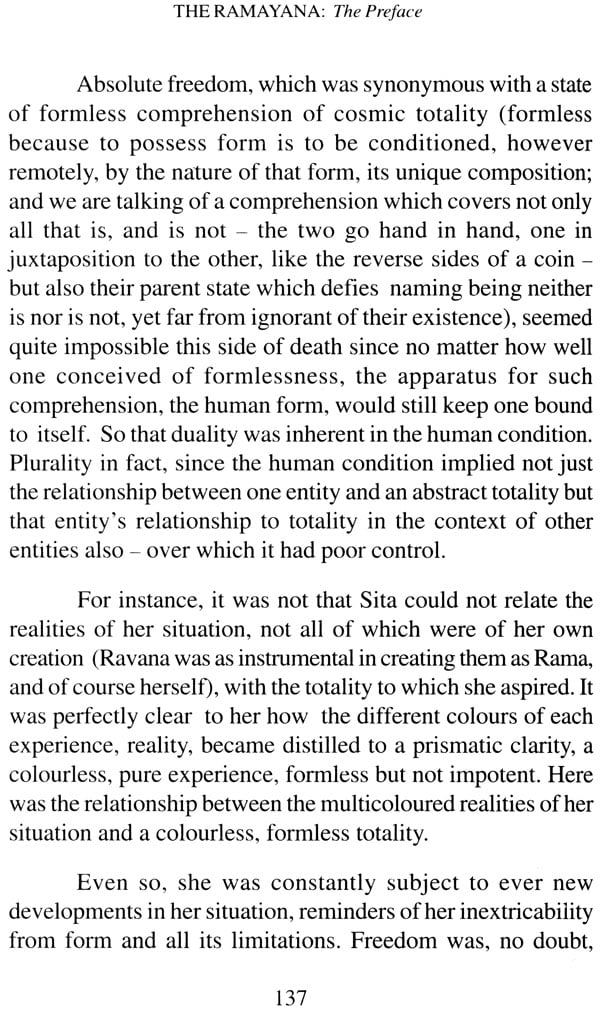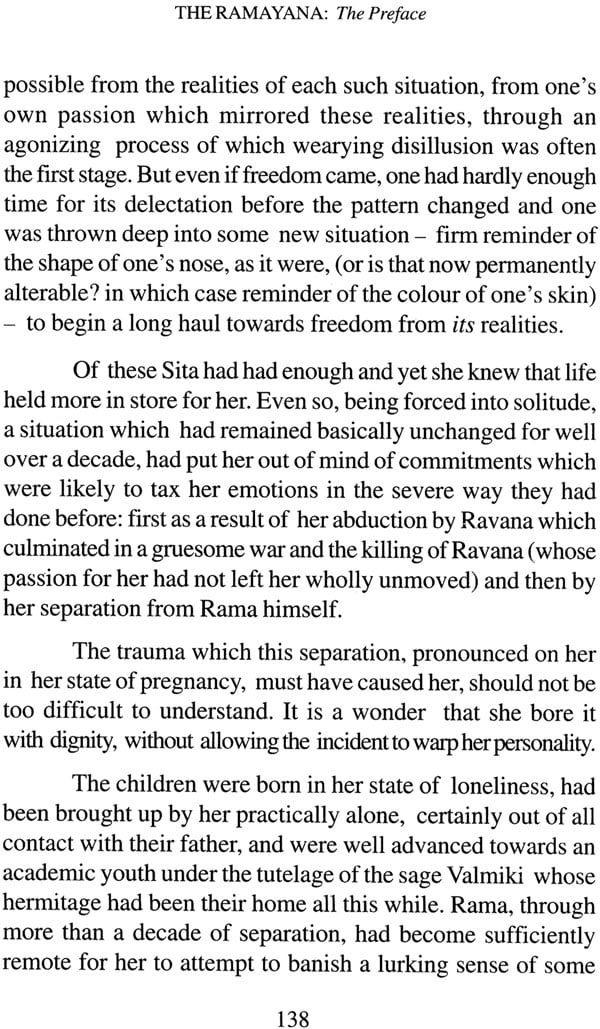
The Ramayana (The Epic, As A Play In English) (Applauded World Wide Over 2000 Performances of Jalabala Vaidya)
Book Specification
| Item Code: | IHL301 |
| Author: | Gopal Sharman |
| Publisher: | Bharatiya Vidya Bhavan |
| Edition: | 2005 |
| ISBN: | 8172763298 |
| Pages: | 155 (15 B/W Illustrations. |
| Cover: | Paperback |
| Other Details | 8.4 Inch X 5.4 Inch |
| Weight | 300 gm |
Book Description
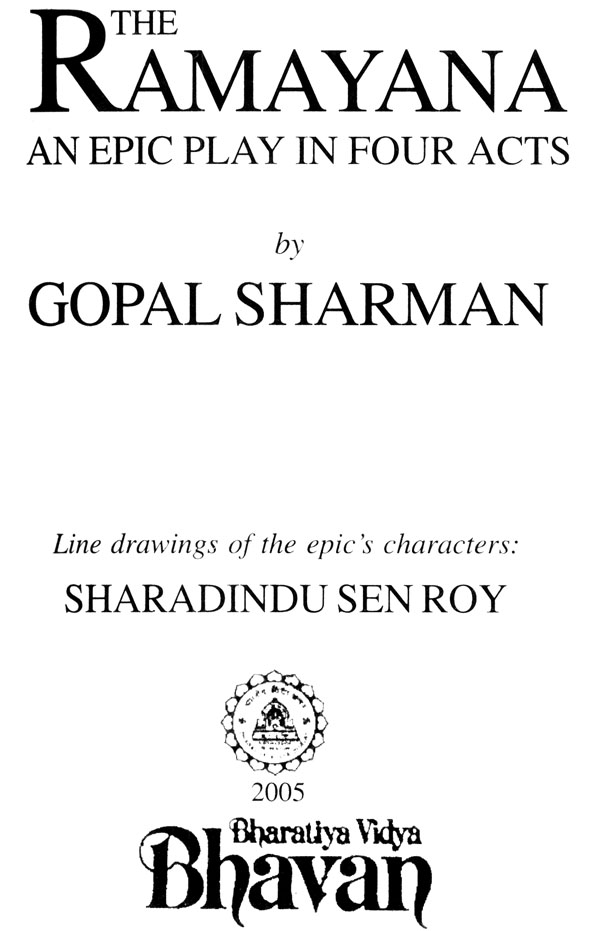
I wrote the Ramayana to be played by a full cast of actors, dancers, musicians and singers.
Two insurmountable problems cropped up after the writing when I tried to put a competent professional production together. First there were no professional theatre actors available anywhere in India because there was no professional urban theatre in the country. Second even if I could have picked from the amateur talent that was available in order to drill them into a professional team there were no discerning patrons to provide the initial subsidy such an enterprise needed.
Regardless and somewhat naively it tried to create both a team sufficient dedication in a venture that afforded no financial security and patrons who seeing such a team would risk their money on the enterprise not surprisingly I came to grief.
But not wholly. The bitter sad experience compelled me to try a humbler experiment of doing the play as a katha. Katha (Sanskrit) means simply, story but in another sense the world conjures up for most Indians today the picture of a solitary person telling stories form Hindu mythology. It is through this institution of the katha that India’s literary masterpieces continued to be available to a people whose culture suffered brutal conquest for almost a thousand years.
Unlike in Europe India’s urban centers the great cities plundered time and again have not evolved such means of artistic dissemination as living theatres or publishing of any substance. Through all the nine-hundred plus years of conquest the burden of keeping the literature of a high civilization form becoming extinct was borne admirably by the katha vachala. There is no Indian educated or illiterate who has not witnessed a katha. The from of a solitary person telling mythological stories and illustrating right and wrong through them came in handy to people like Mahatma Gandhi who called his public meetings prayer meetings and which were indeed fashioned in every detail on the Katha.
The years preceding and following independence produced among much else a theatre movement of sorts a great mushrooming of amateurs promise but no fulfillment certainly no one to employ the katha as a theatrical form. This is what I devoted myself to doing for several years and with the help of Jalabala Vaidya in the role or the katha vachaka. I have had the satisfaction of at least proposing to people in my own country and also to a highly receptive theatre community internationally that here was excellent dramatic material a potential theatrical medium with a technique practiced and perfected over several hundred years.
Casting the play in this new mold of a katha I had to slightly rework the script as indeed I would have done even to produce the play conventionally with a full company.
Leaving therefore the script changes which were minimal and routine I now come to the more interesting exercise of devising a whole new pattern of stage movement the austere stage furnishings performer’s props the costumes all to enable the solitary katha vachaka to portray. The Ramayana’s 20 different characters in seven entirely different locales without a Gene Detro as well put it in his Oregon Journal Review of the performance one bluring identities.
Caution! This isn’t to be an attempt to codify the details of Jalabala’s performance to serve as pattern for others who might want to play the Ramayana as a katha. Jalabala’s Ramayana is a tour de force one of world theatre’s great performances. The extraordinary range of Jalabala’s voice enabled her perhaps I devised to etch out the characters establish their individual identities. It was a memorable experience for me as a playwright/director working with a consummate actress who not only responded scrupulously to direction but also had the intelligence to substantially and creatively add to it. Nothing of all that has been codified or indeed can be codified.
But a broad framework did evolve from all out years of doing The Ramayana as a katha out of this ancient Indian style of storytelling a theatrical framework of considerable sophistication a precious gift to the urban theatre of our times.
Now that framework first setting the stage for it.
The traditional katha has the katha vachaka seated on a low chair at one end of the stage or dais up front. On a little table before him is a well worn book of the epic from which he will tell the story. The center piece on the stage is an image or piece on the stage is an image or picture of the deity whose story is to be told with a shining brass or copper plate full of flowers at its feet. Perhaps a few other artifacts of worship like a conch shell a five wick votive lamp an offering of sweets for distribution among the audience at the end of the katha and that is all. The stage is set for a katha.
How very economical. Let us not tamper with such a cost saving arrangement. But be certain to get a fine piece of sculpture or faithful reproduction thereof, to play the deity, positively not a glossy calendar picture. It is amazing how well a piece of classical sculpture can perform under clever lighting. And about lights the five wick votive lamp makes a starting effect used by itself at the right moment in the play with nothing else to light the stage. Hold it close and it adds a whole new dimension to your face. Put it at the foot of the sculpture and see the image come to life in the flickering light. If it is a small audience let the katha vachaka hand out the flowers or sweets to each one as they file out of the hall at the end of the performance. When we played to large audience Jalabala went down into the hall to give away the flowers in the first row of seats.
Now that story teller’s chair! Get to work on it. Shift it about on the stage from scene to scene. Act to act alter its appearance maybe with a different back each time. Or take the back off altogether. Remember also the little table with the book on it. Move them about too. There is no end to the uses to which these items of property can be put.
This is certain if there is nothing else on the stage by way of sets and properties anything you wish these few minimal stage furnishings to communicate will indeed be communicated to the audience. Keep in mind the locale the mood of the scene you are to play. Then use as best as you can your chair and little table to conjure up that locale and mood. In doing the Ramayana is in addition there was an image of Hanuman the monkey god also never shifted from its position front stage right to balance the katha vachaka’s chair front stage left. I shall describe the scene setting at the beginning of each act or scene in which the appearance of the katha vachaka’s chair was altered or the chair was moved from its placing at front stage left.
Ideally the katha vachaka should never resort to reading from the book. Open it once at the start of the performance and then leave it alone. Remove it form the stage altogether in the dark between the scenes. Or being it back in the last scene merely to close it is signify the end of the play. By this I am not suggesting that a katha be done without a script or for that matter only half a script and half improvisation ad lib. The actor who chooses to invent the dialogue as he goes along is either a literary genius in addition to bring an actor or simply story and then to learn his script by heart. Speaking for myself it wasn’t adapting my original play as much as memorizing the adoption that proved to be hard work and the latter fell all to Jalabala’s lot learning by heart the whole two and a half scripts. What a feat! We used the book on stage but merely as a prop only in the first scene and last. I have already cautioned myself to desist form codifying the details of Jalabala’s performance. Such details as omitting names of characters in the scenes to preface each character’s lines. Jalabala’s let the audience know who was saying what by dexterous tonal inflections carefully executed movements and so on. If the stage was peopled with several characters in a scene she know exactly who was standing where she knew their ages how tall or short they were and because she knew all that and more about each character it wasn’t difficult to put it across to the audience.
But stop! This isn’t a book on the actor’s craft.
The subject of our study is the katha how to learn from this ancient style of storytelling that has been practiced for centuries in India and see if we cannot evolve an urban theatrical form out of it. Therefore having observed how the stage is set for a traditional katha and made some notes on how a degree of modern day theatrical sophistication might be introduced to that format shell we return to the katha as it is conventionally done see the performance begin?
Here then is the katha vachaka taking his position on the stage and chanting a memorized invocation to the deity-after which he opens the book and reading a verse to two from it explains its literal meaning to the audience as well as its relevance to their lives and times. The good katha vachaka has the book by heart at least the portions that he or she is going to tell. The verses from the epic that are well known to the audience provide him with an opportunity to express his creativity in a skilful very often musical chanting that needs as all good music does no explanation. The lesser known verses provide the opportunity for interpretation a linking of an ancient story to present day situation.
Taking from all of that but keeping in mind that I have stated with precision in the script what I found in the epic story of relevance to our own situation I evolved a formal framework for my own version of the katha a step by step method by which the katha vachaka moves from his/her own time and its dilemmas to the time and events of the story that is to be told and which story points to a resolution of some of the issues we face in our own times.
| The Epic’s principal characters | 1 |
| Introduction | 2 |
| Act One : Ayodhya | 16 |
| Act Two: Exile | 35 |
| Act Three: Lanka | 56 |
| Act Four: Ayodhya | 88 |
| A Note on the Preface | 104 |
| The Preface | 105 |
| A Postscript | 142 |
| The Akshara Ramayana | 146 |
